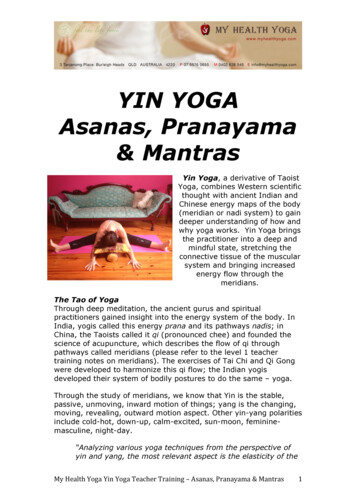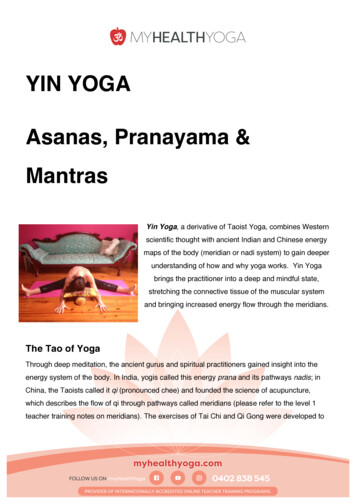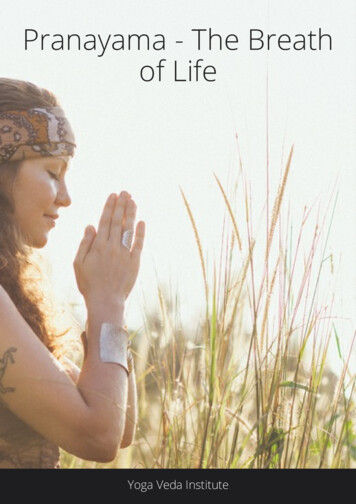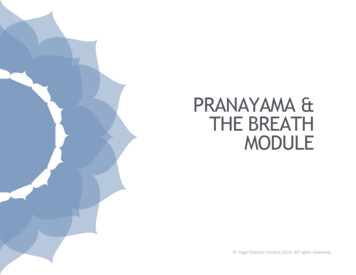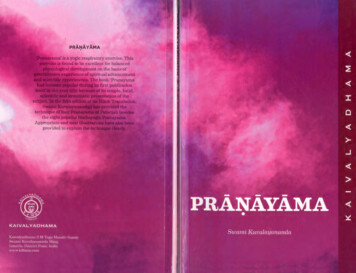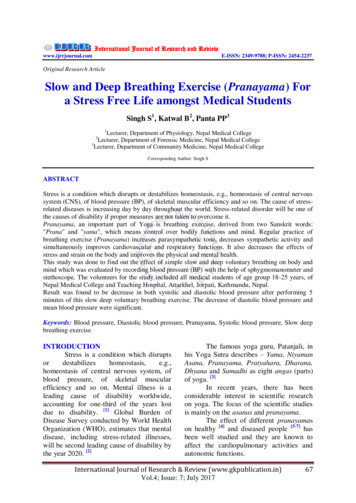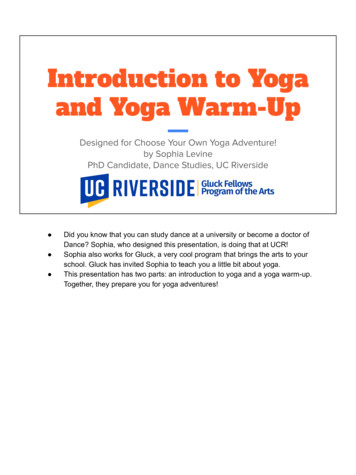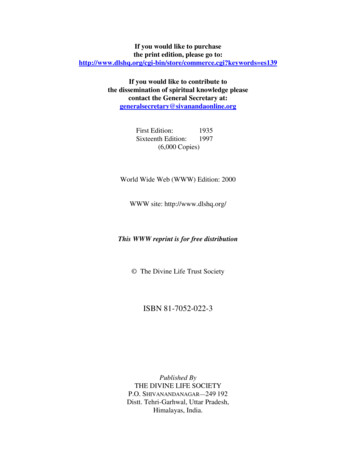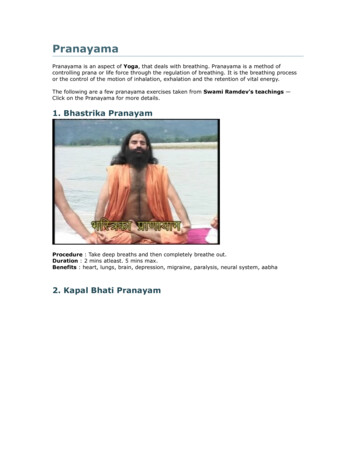
Transcription
PranayamaPranayama is an aspect of Yoga, that deals with breathing. Pranayama is a method ofcontrolling prana or life force through the regulation of breathing. It is the breathing processor the control of the motion of inhalation, exhalation and the retention of vital energy.The following are a few pranayama exercises taken from Swami Ramdev's teachings —Click on the Pranayama for more details.1. Bhastrika PranayamProcedure : Take deep breaths and then completely breathe out.Duration : 2 mins atleast. 5 mins max.Benefits : heart, lungs, brain, depression, migraine, paralysis, neural system, aabha2. Kapal Bhati Pranayam
Procedure : Push air forcefully out. Stomach will itself go in.Duration : Start with 30 times or 1 min. increase upto 5 mins min. upto 10 mins max.Benefits : aabha, tej, obesity, constipation, gastric, acidity, Croesus(liver), hepatitis B, uterus,diabetes, stomach problems, cholesterol, allergic problems, asthma, snoring, concentration,and even cancer and AIDS.Tips : heart and high BP patients, and weak people do it slowly.Swamiji says "dharti ki sanjivini hai kapal-bhati pranayam" and that it "cures all diseases ofworld".3. Baharya PranayamProcedure : Breathe air out, touch chin to chest, squeeze stomach completely and hold for awhile. then release chin, breathe in slowly.Duration : 3 times to 5 times normally. max upto 11 times. and extremely max upto 21 times(in winters).Benefits : stomach(udar), hernia, urinal, uterusTips : not for heart and high BP patients
4. Anulom Vilom PranayamProcedure : Hold your right nasal with thumb, breathe in from left. Now open right nasal andclose left nasal with middle and ring finger and breathe out from right nasal. Now breathe infrom right nasal. Now close right nasal and open left and breathe out and in from left nasal.and so on.Duration : atleast 10 mins.Benefits : heart, high BP, heart blockage, vat-cuf-pit, arthritis, cartilage, bent ligaments,sinual fluid reduced, parkinson, paralysis, neural related, depression, migraine pain, asthma,sinus, allergyTips : breathe into lungs not to stomach. no organ in stomach absorb oxygen. Do not hurry.Do it slowly. Rest whenever needed (in any pranayam).5. Bhramri Pranayam
Procedure : Close ears with thumb, index finger on forehead, and rest three on base of nosetouching eyes. Breathe in. And now breathe out through nose while humming like a bee.Duration : 10 minsBenefits : tension, hypertension, high BP, heart, heart blockage, paralysis, migraine pain,confidence, concentration6. Udgeeth PranayamProcedure : Breathe in deeply, and chant 'Om'kar. OOOOOOm ( long O and small m )Duration : 10 mins or moreBenefits : meditation
Some rules for Pranayam Select a clean and peaceful place for doing Pranayama. If possible, choose a placenear a clean pond or river.As there is a lot of pollution in the cities, some kind of incense can be lit like Gugguluand purified butter, to create a clean environment at that place, igniting a lamp withpurified butter only, can also serve the purpose.Sit either in any of the Asanas, viz. Padmasana, Sidhasana or Vajrasana, which everyou find convenient. The sheet or cloth (cotton or wool etc.) on which you sit must bea non-conductor of electricity.Breathe only through the nose, because by doing so the air which you take in, isfiltered. During daytime when you are not sitting for the performance of Pranayamamake it a habit to do respire only through nose and not through mouth. Nasalrespiration keeps the temperature of the Nadis (Vessels) –'Ida',Pingala and 'susmana'even. It also prevents foreign and harmful objects from getting into lungs.Like ‘Yog’, Pranayama should also be performed four or five hours after taking food. Inthe morning Pranayama should be done after finishing daily routine acts like cleansingmouth, emptying of bowels etc., it should also be done before Yogsana. In thebeginning Pranayama should be done for five or ten minutes gradually the time maybe increased up to about 1/2 or 1 hour. Maintain a specific number of repetitions anddo not variate. Maintain a specific rhythm. If it is not possible to clean the bowels bymorning, at night take some mild laxative like terminalia chebula (Indian Hardaya) orany other mild laxative (a non habit forming medicinal herb having a laxative effect).Kapala-bhati Pranayama, if done regularly for a few days will help in curingconstipation.Keep your mind calm and composed. However, Pranayama can also calm down thedisturbed mind and keep one happy.o Methods of Pranayama may be varied according to the seasons and your ownphysical make up and mental attitude. Keep this in mind and modulate themethod accordingly. Some Pranayama increase the body temperature,whereas, some bring it down. Some Pranayama maintain the temperature atthe normal level.If you feel fatigued in the course of doing Pranayama , rest for sometime and thenbegin deep breathing, which will remove the fatigue.Pregnant women, hungry persons, persons suffering from fever and those who arelustful having no control on their passions should not do Pranayama . If you are sick,keep in mind the instructions to be followed by sick persons while during Pranayama.For prolonged exercises of Pranayama, observance of celibacy is necessary. Besides,food should be simple not containing irritating spices. It should be ‘Sattvika’ – (Plainand simple, non-spicy food). Use of cow’s milk, ghee (clarified butter), fruits and greenvegetables can be said to be ideal food. Moderation also is a good rule to observe.Do not strain yourself while doing ‘Kumbhak’ i.e. retaining the breathed air inside orkeeping the air out after exhaling (Breathing in is called ‘puraka’, retaining thebreathed air in is called ‘Kumbhak’ and exhaling the air is called ‘Recak').Pranayama does not mean just breathing in, keeping the breathed air in and exhalingit. It also means establishing control on the entire breathing process, and maintainingmental equilibrium, and concentration of mind.It is beneficial to chant the mantra (a group of words that carry vibrations and energy)Om (the first cosmic soundless sound), aloud and repeat the same several timesbefore doing Pranayama. Even recital of sacred songs in the praise of almighty God orrecital of some sacred hymns may be beneficial. This will calm your mind and makeyou fit for Pranayama, because a peaceful mind is very essential while doingPranayama . Mental or loud recitation of Gayatri Mantra (considered as one of the
greatest mantra, used in meditation and also for chanting) or any other sacred hymnbrings spiritual benefits to the Sadhaka.o See that while doing Pranayama , none of your organs such as mouth, eyes,nose, etc. feels any strain and it should be done gradually without any unduestress or strain. All the organs of the body should be kept in normal condition.While doing Pranayama sit in an erect posture. Keep your spine and neckstraight. This is essential for reaping the full benefit of Pranayama .If possible Pranayama should be done after your usual morning functions like cleansingof mouth, evacuation of bowels, bathing etc. However, if it becomes necessary for youto take bath after Pranayama , keep an interval of about 15 to 20 minutes betweenPranayama and bathing. For acquiring proficiency in Pranayama do not depend onbooks or what is done and preached by others. Seek the guidance of an expert and doPranayama under his direct supervision.o Different treatise advocating or dealing with the subject of Pranayama describeseveral methods and each of them has its own importance. However, it is notpossible for most people to do all these exercises daily. Hence, with theblessings of our teachers and in view of our experience, we have evolvedseven methods of Pranayama , which incorporate into themselves, almost allthe peculiarities of Pranayama rendering them scientific and useful from aspiritual point of view. All these seven types of Pranayama can be done, as aroutine and in a time bound programme of about 20 minutes. The person whodoes these exercises daily and regularly can attain following benefits which arebriefly described as under:All the three Doshas (Humors) - Vata , pitta and Kapha get adjusted in properproportion and abnormalities in them are removed.Digestive system improves and diseases pertaining to digestive organs are cured.Diseases pertaining to lungs, heart and brain are also cured.Obesity, Diabetes, Cholesterol, Constipation, Flatulence, Acidity, Respiratory troubles,Allergy, Migraine, High blood pressure, diseases pertaining to kidneys, sexual disordersof males and females etc. are also cured.Resistance against diseases is stepped up. Immunity develops.Hereditary diseases like diabetes and heart disease are can be avoided.Falling of hair or its premature graying, appearance of wrinkles on face or other partsof the body at young age, diminution of eye sight, forgetfulness, etc. are relieved andprocess of aging is retarded.Face becomes bright, luminous and calm.Energy Chakra are cleansed and enables the practitioner to awaken the Kundalini.Mind becomes stable and tranquil. A sense of contentment and enthusiasm or zealdevelops. Conditions like depression are relieved.Performance of yogic exercises like meditation will be easy.All the diseases of the physical and etheric bodies will be cured. Freedom fromnegative and harmful mental conditions like anger, lasciviousness, greed for money,arrogance etc. will be achieved.All the physical and mental disorders and abnormalities are cured and toxinseradicated from the body.Freedom from negative thinking is achieved and the mind develops the habit ofpositive and constructive thinking.Swami Ramdev MaharajPujya Shri Baba Ramdev Maharaj ji is a renouned Yoga and Ayurved guru. He is is well-versedin Sanskrit Grammar, Ayurveda and Vedic Philosophy. His practical approach to Yoga has wonhim millions of followers throughout India.Swami Ramdev was born as Ramkishan in a very humble family of a farmer in Narnaul village
at Alipur, in Mahendragarh district of Haryana. Two and half months after he was born half ofhis body was paralysed but he recovered. He escaped death about seven times.He studied in his Narnaul village school till 5th. He studied up to Class 8 in nearby villageShahjadpur and then joined a gurukul in Khanpur village to learn Sanskrit. From there he wentto Jind district and joined the Kalva gurukul under Acharya Baldev ji Maharaj and laterimparted free Yoga training to villagers across Haryana. It is said that he travelled theHimalayas for several years before he settled in Haridwar. He spent a considerable amount oftime in the caves of Gangotri. He discovered several medicinal plants in the Himalayas whichhe uses in treating his patients, apart from reeking the benefits of cow’s urine and manure.Swami Ramdev started relentless efforts to popularise Yoga in 1995 with the esteblishment ofDivya Yoga Mandir Trust, along with Acharya Karamveer and Acharya Balkrishna. WhileKaramveer is well-versed in Yoga and the Vedas, Balkrishna is a physician with a degree inAyurveda. Ramdev became the president of the trust, Karamveer the deputy president andBalkrishna the general secretary. The objective of the trust was to reach Yoga in every part ofthe country and cure as many patients as possible. With this he began activities in health andspiritual pursuits and has cured many incurable diseases since then.Now thousands of people everyday attend his Yoga camps. And many are following him inYoga through TV channels and Videos. Swamiji has given a new birth to Yoga by bringing itto public and benefiting people with it. He has helped Yoga become popular among commonman. He has done so by curing many incurable diseases. He is responsible for a revolution inYoga and health.Guru Ramdev has planned a Rs 100-crore dream project, Patanjali Yog Peeth, atBahadrabad, about 20km from Haridwar. According to him, "It will catapult Yoga and Ayurvedato its zenith, and lead to mental, spiritual and physical development of people". To becompleted in three years, it is an ambitious project with a Yoga university, a naturopathydepartment which can handle 1,000 patients at a time, a residential complex for patients, ahall for 5,000 people to practise Yoga and the world’s largest hospital ward to treat 5,000patients a day.Swamiji believes that "yog se yeh Aaryavrat desh punah Vishva guru ke garimamay pad parpratishthit hoga" ( India will again become world leader through Yoga ). He dreams of a "rogmukt Bharat Varsh aur Vishva" ( Disease free India and World ).When was Swami Ramdev ji BornBirth date of Swami Ramdev ji not known.Swamiji took sanyas in 1995.The estimated year of birth of Swami Ramdev ji is 1965 - 1970, which makes him 35 - 40years old as of 2005.Swami Ramdev was born as Ramkishan in a very humble family of a farmer in Narnaul villageat Alipur, in Mahendragarh district of Haryana.
Pranayama is an aspect of Yoga, that deals with breathing. Pranayama is a method of controlling prana or life force through the regulation of breathing. It is the breathing process or the control of the motion of inhalation, exhalation and the retention of vital energy. The following are a few pranayama exercises taken from Swami Ramdev's .
